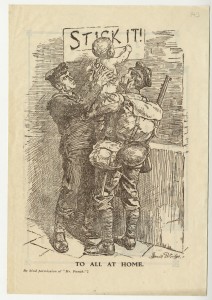We continue our series of blogs that look at the impact of the First World War on The Children’s Society. This post written by one of The Children’s Society Archive team, Clare McMurtrie, considers particular issues during the First World War – fundraising and advertising.
The Children’s Society’s Archive holds a fascinating collection of 523 fundraising flyers that were inserts in The Society’s former supporter’s magazine Our Waifs and Strays. The inserts date back to The Society’s beginnings in the 1880s, when it was known as the Church of England Waifs and Strays Society, and were often beautifully illustrated. The Society’s fundraising flyers chart not only the history of The Society itself, but also its place within history – from the workhouses and Poor Law of the nineteenth century, to the First and Second World Wars of the twentieth.
During the First World War fundraising was important to The Society (and other charities) as it sought to raise extra funds through advertising to support families affected by the War. Flyers included the one above from October 1914, which has a photograph of a young man in uniform who was formerly in the care of The Society, alongside the caption ‘For Church and Country’ inside a flag. Another First World War flyer is one which includes an illustration commissioned from Bernard Partridge. This insert was used in January 1918, at the tail end of the War, in the same month as British Premier and Liberal politician David Lloyd George (1863-1945) gave a speech to Trade Union delegates to outline British War Aims. The insert and its caption ‘Stick It!’ reflect the resilient and determined wartime spirit and the message of Lloyd George’s speech.
Sir John Bernard Partridge, known as Bernard, was born in London on 11th October 1861, the youngest son of Professor Richard Partridge and Fanny Turner. His uncle was John Partridge, Portrait Painter Extraordinary to Queen Victoria and he was educated at Stonyhurst College at the same time as Arthur Conan Doyle, before attending Heatherley’s and the West London School of Art.
Partridge had worked as a decorator of church interiors, but freelanced as a cartoonist. His first published work appeared in Moonshine, and he also contributed cartoons and illustrations to publications including Judy, Illustrated London News, Vanity Fair, Illustrated Sporting & Dramatic News, Lady’s Pictorial, Pick-Me-Up, Quiver and The Sketch. On the recommendation of George du Maurier, grandfather of author Daphne du Maurier, Partridge first contributed to Punch in February 1891. He joined the staff later that year, going onto work for the magazine for over fifty years, producing political and joke cartoons as well as theatre caricatures. In 1910 Partridge succeeded Edward Linley Sambourne (1834-1896) as Chief Cartoonist, a position he held until his death.
Partridge’s style included being particular about figures in his cartoons and disliking using more than two in any cartoon, while tending to draw elaborate, statuesque figures in classical poses. The ‘Stick It!’ illustration is therefore an unusual example of his work in that it includes three figures; a Navy man, a soldier and a baby. Its message ‘To all at home’ was both a plea for donations at a time of economic hardship across the country and one of solidarity to reader’s plagued by war for four years. He was knighted in 1925 by Prime Minister Stanley Baldwin. Bernard Partridge died in London on 9th August 1945.
Browse through publications of Our Waifs and Strays from 1882: http://www.hiddenlives.org.uk/publications/waifs_and_strays/
Browse the Punch Magazine Cartoon Archive: http://www.punch.co.uk
Learn more about conflict and the First World War: http://www.iwm.org.uk/
For information about The Children’s Society Archive’s ‘Hidden Lives Revealed’ web site: http://www.hiddenlives.org.uk/
or you can consult the Archive’s on-line catalogue: http://www.calmview.eu/childrensociety/Calmview
If you would would like to know about how The Children’s Society continues to change children’s lives today, visit the charity’s website: http://www.childrenssociety.org.uk/


